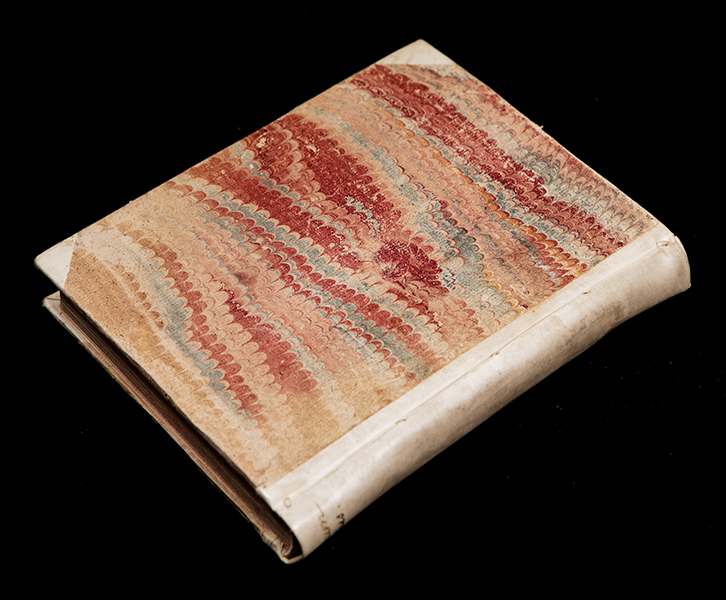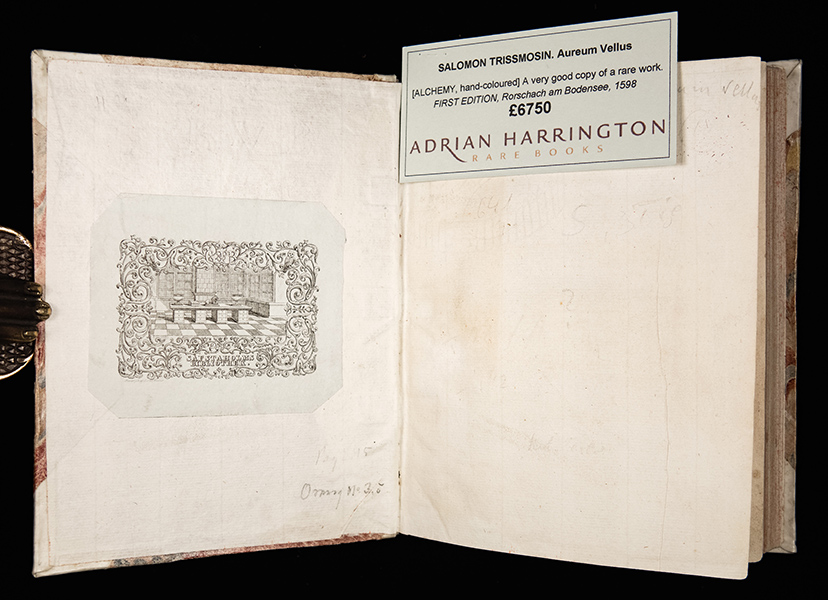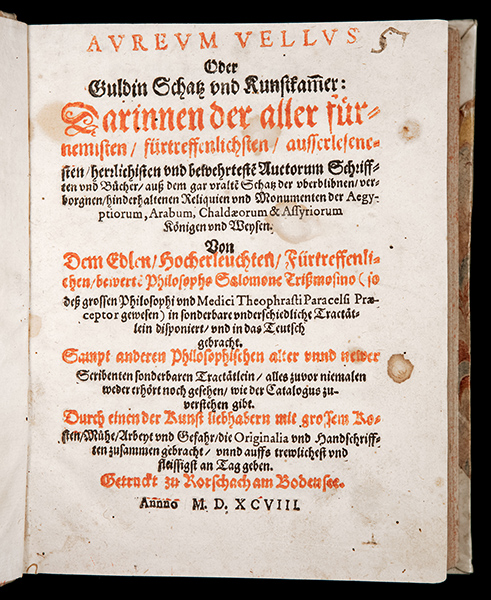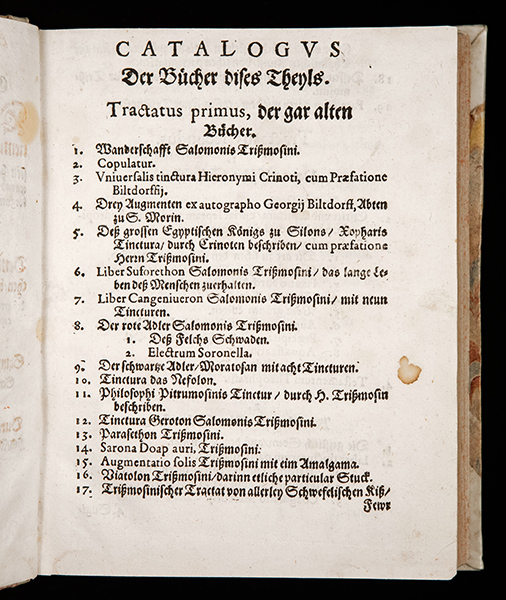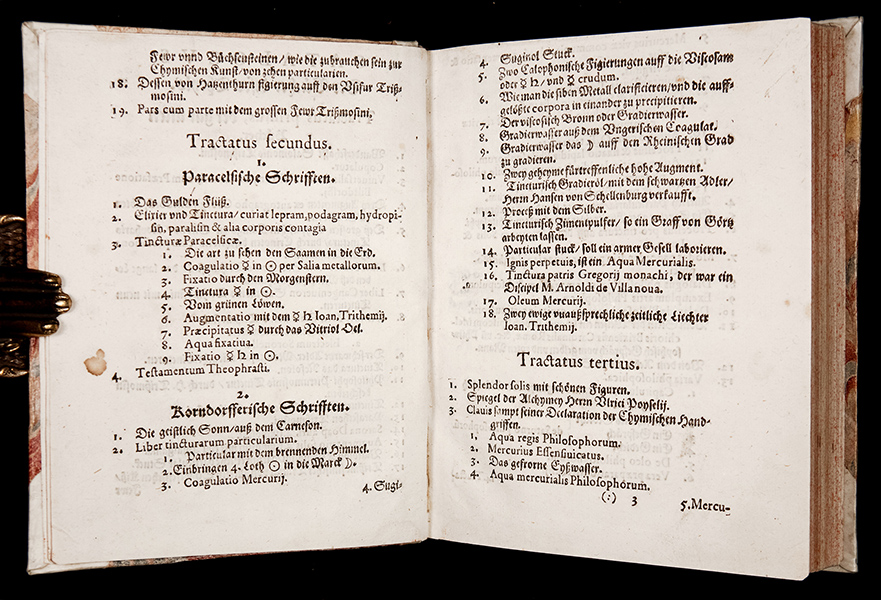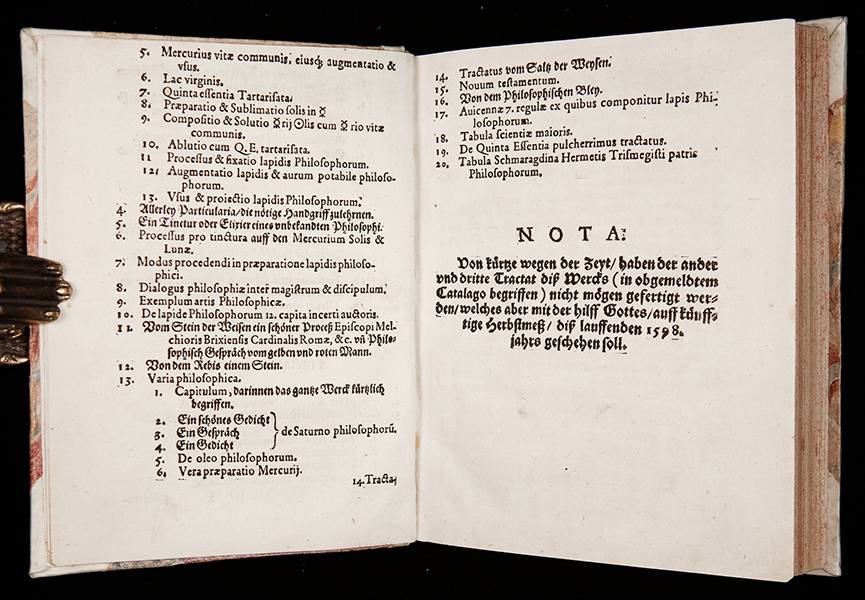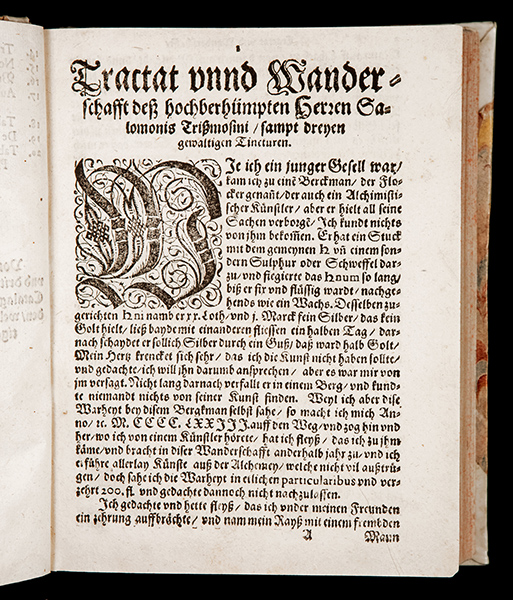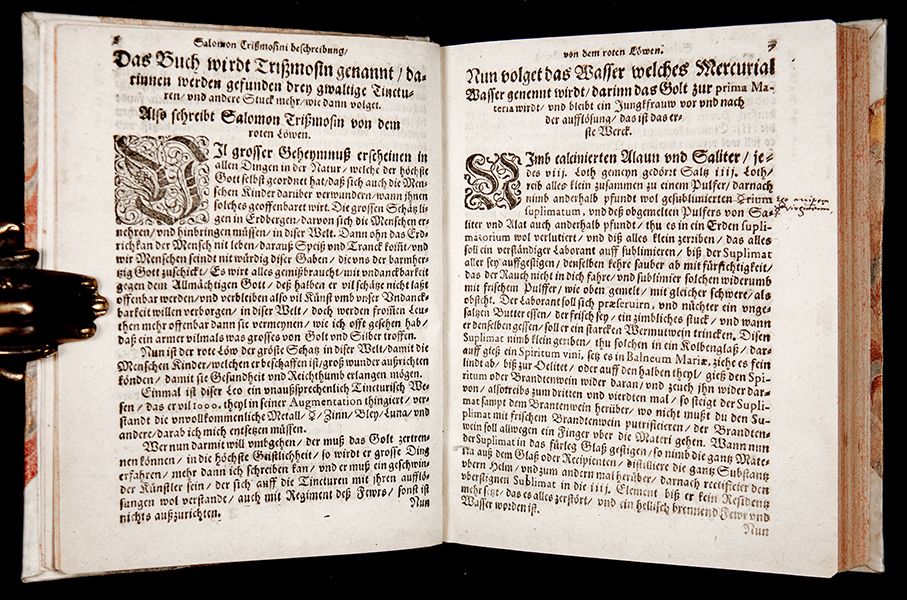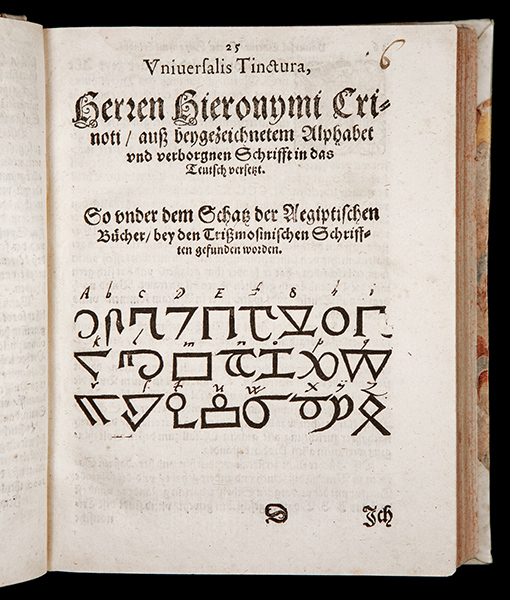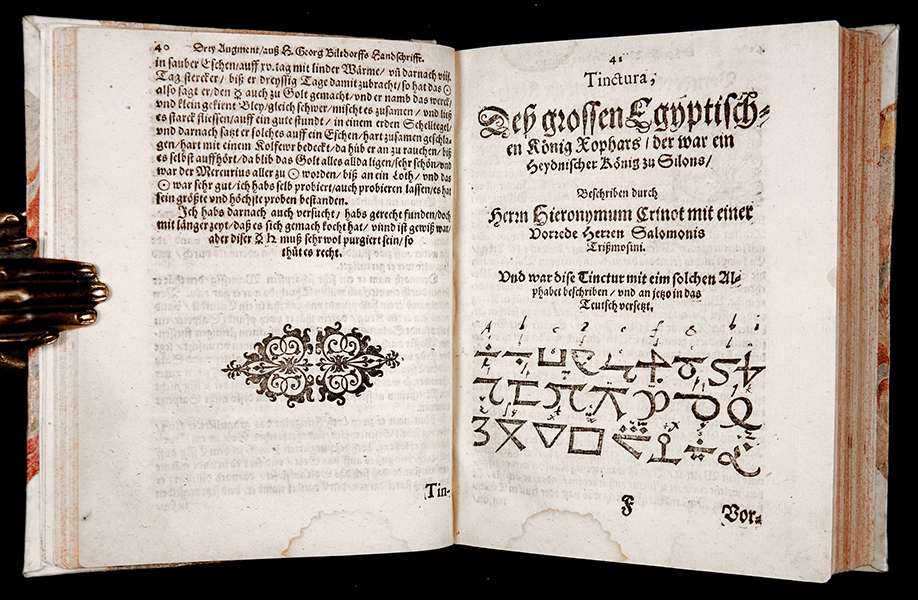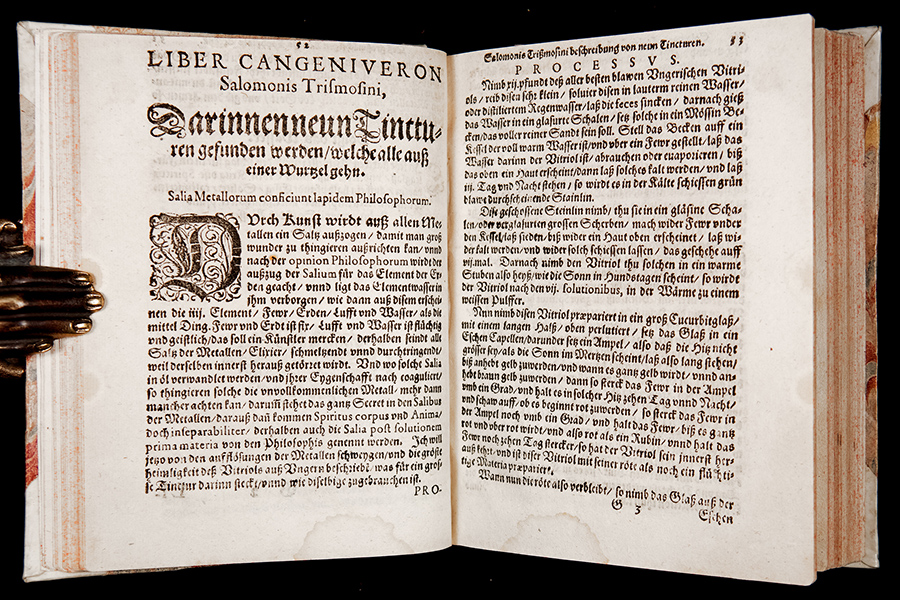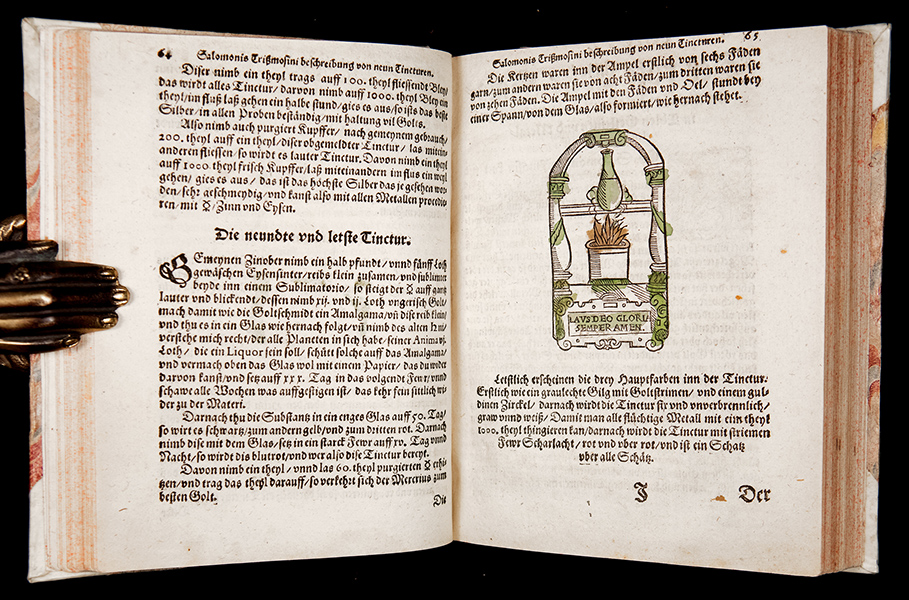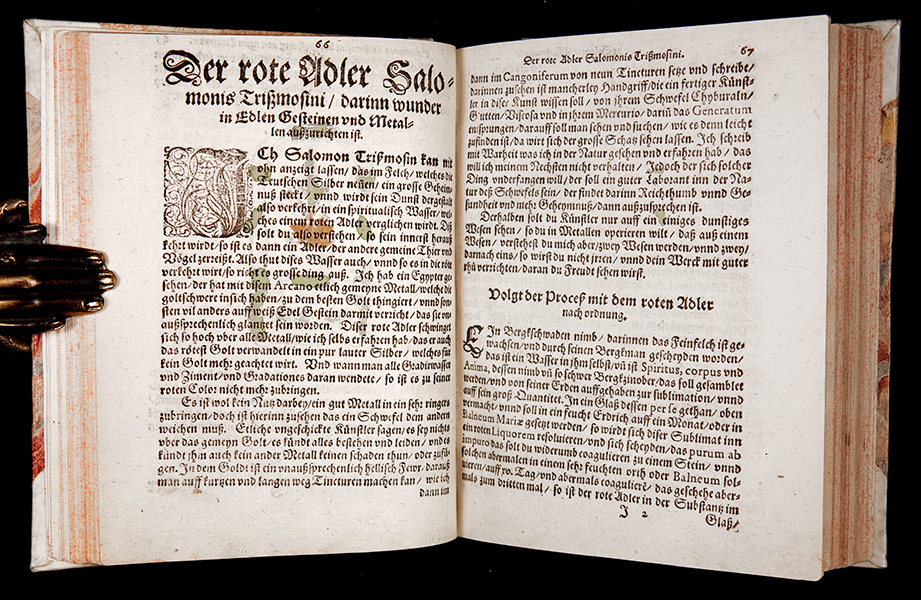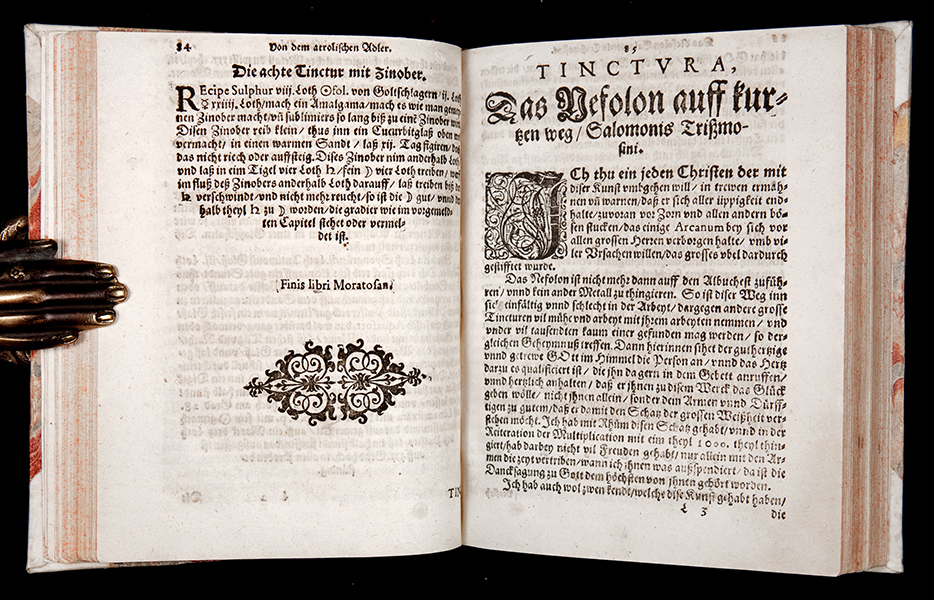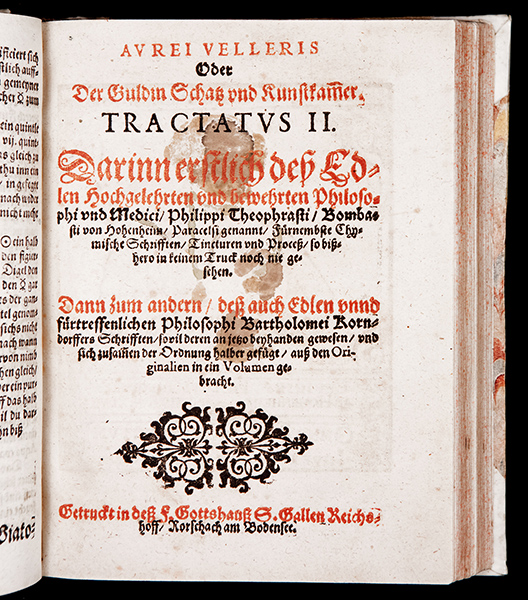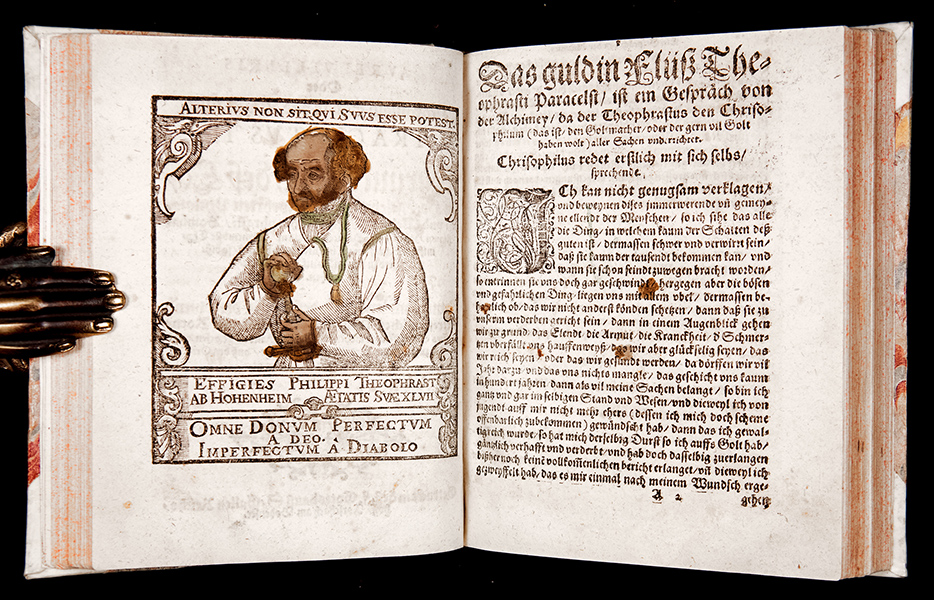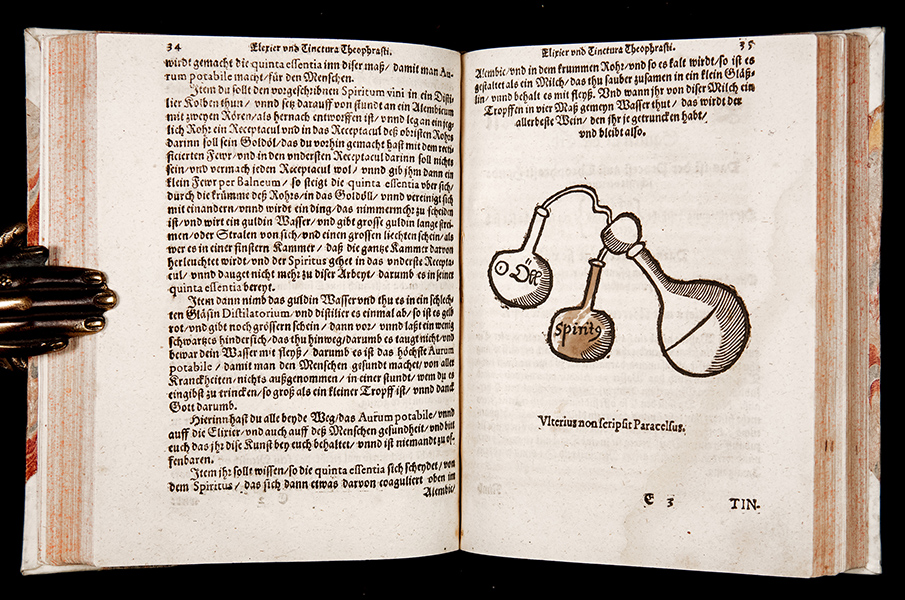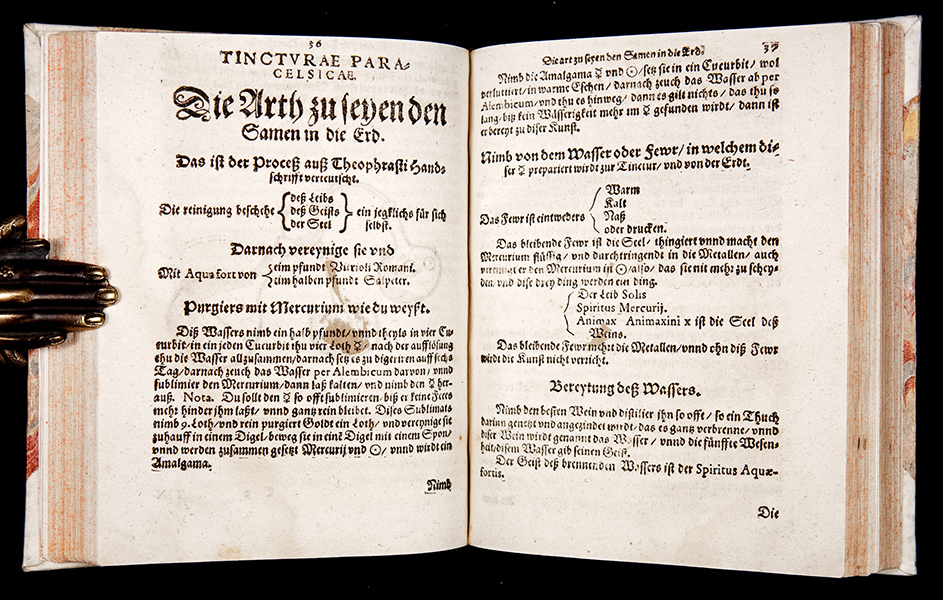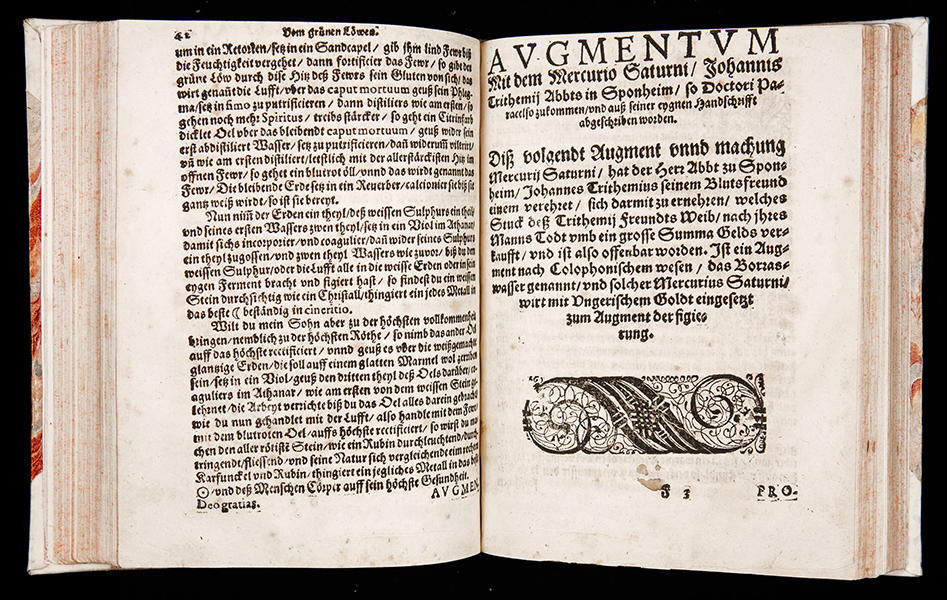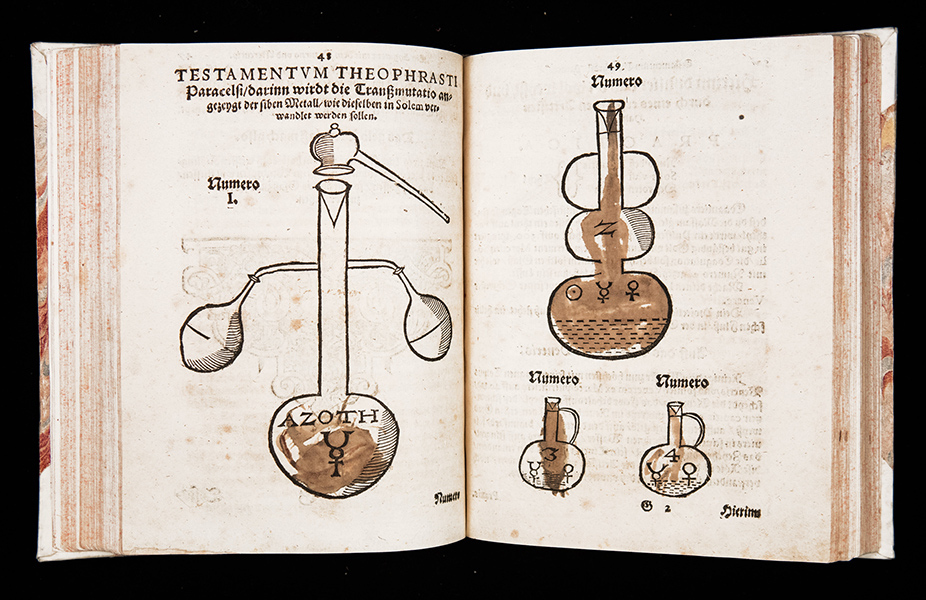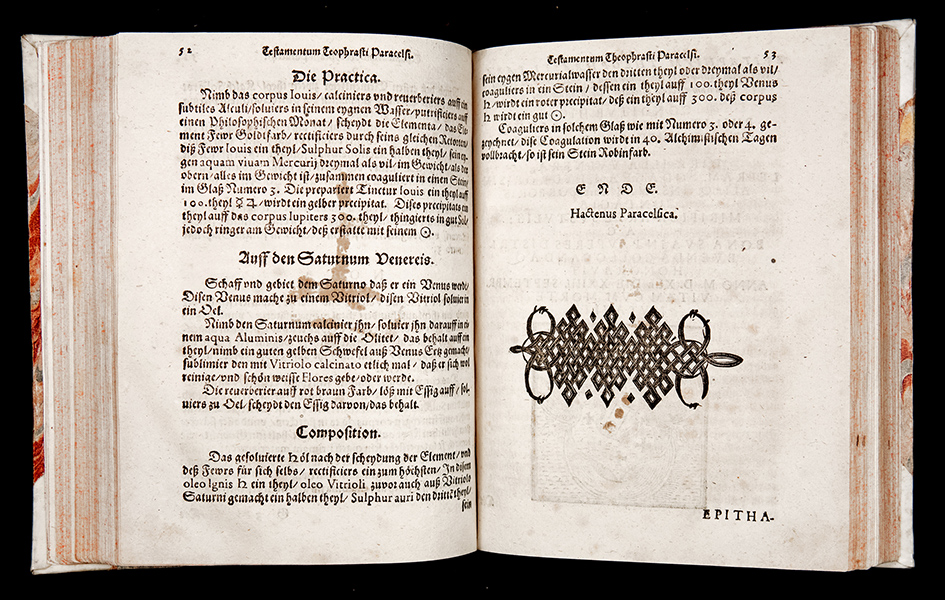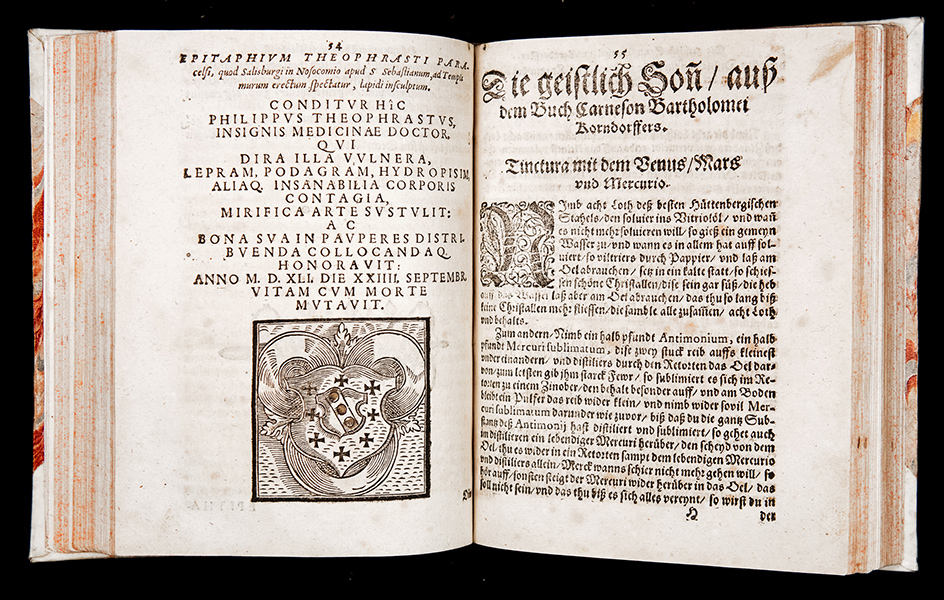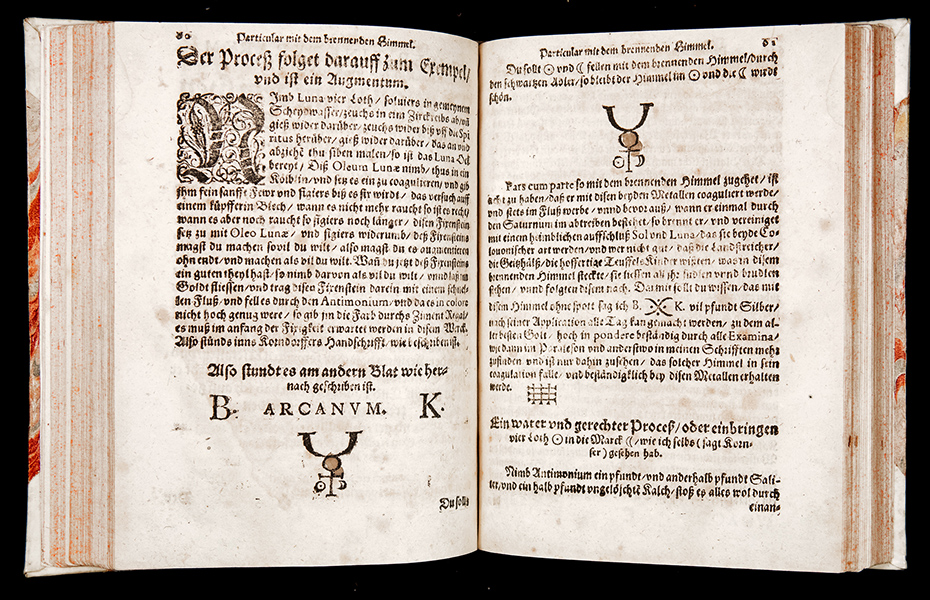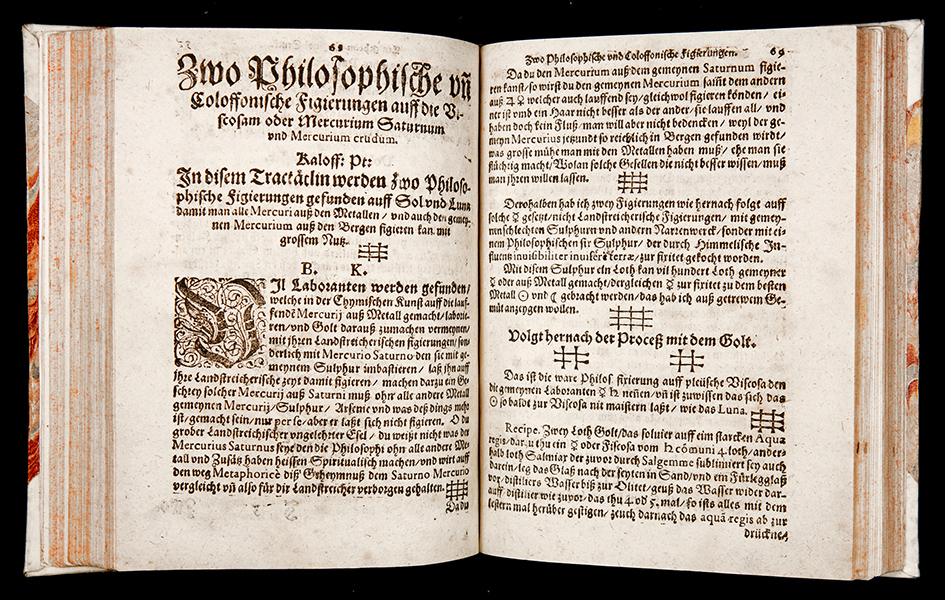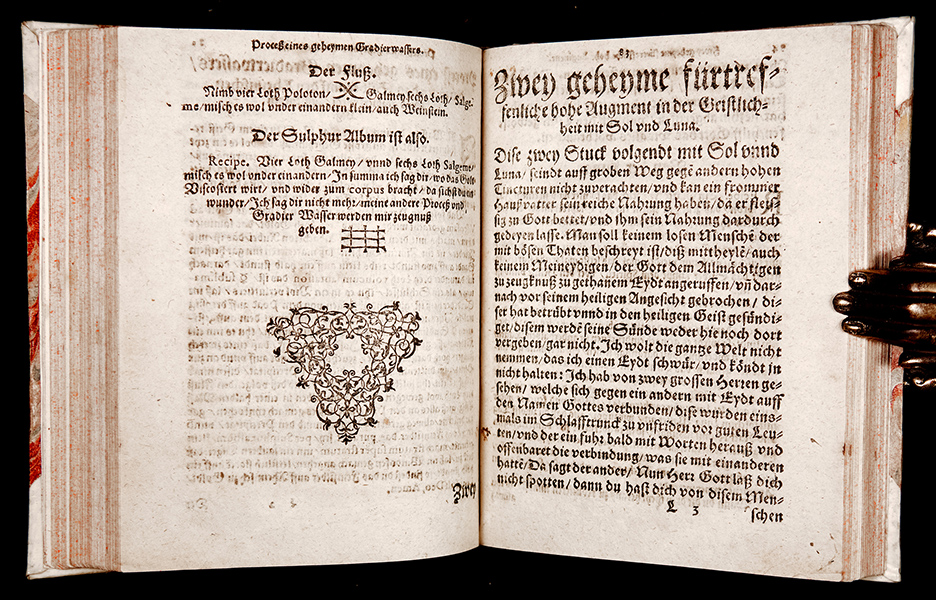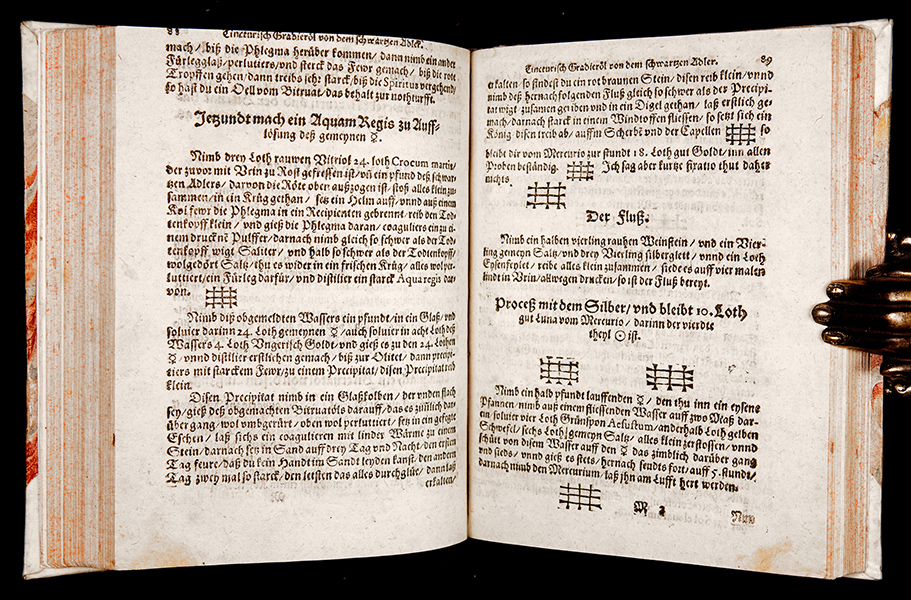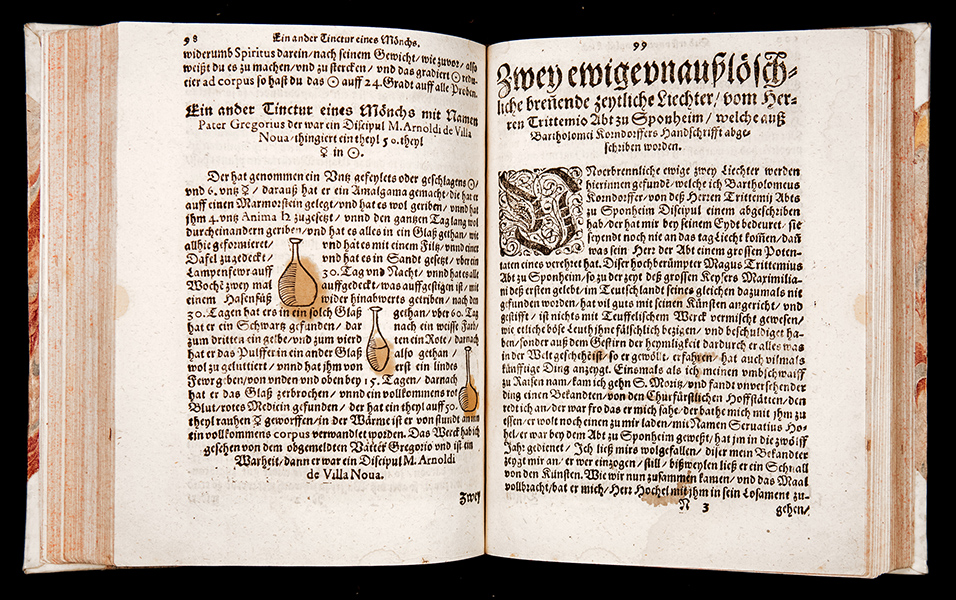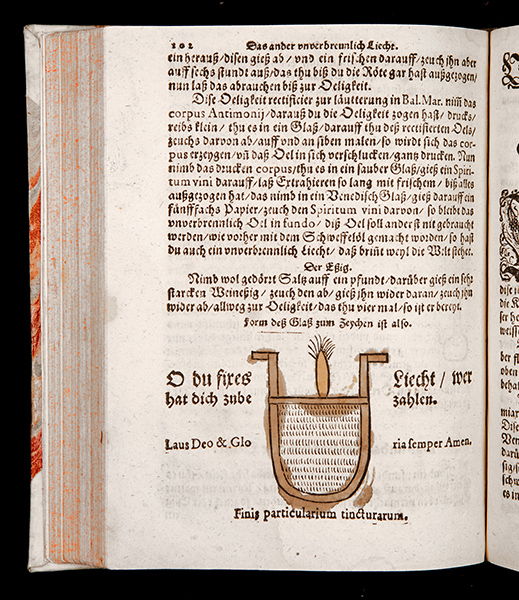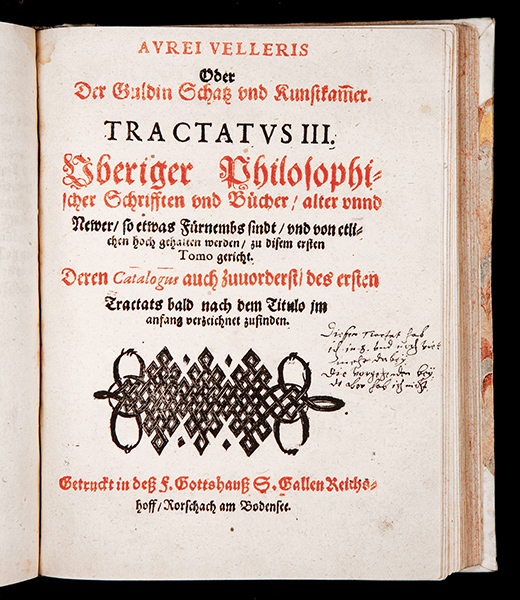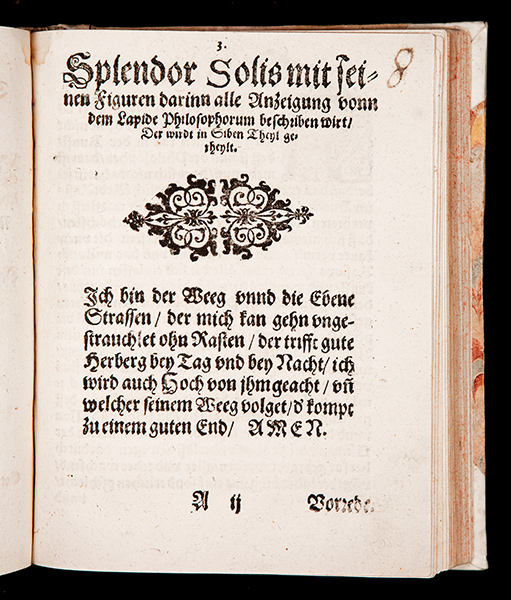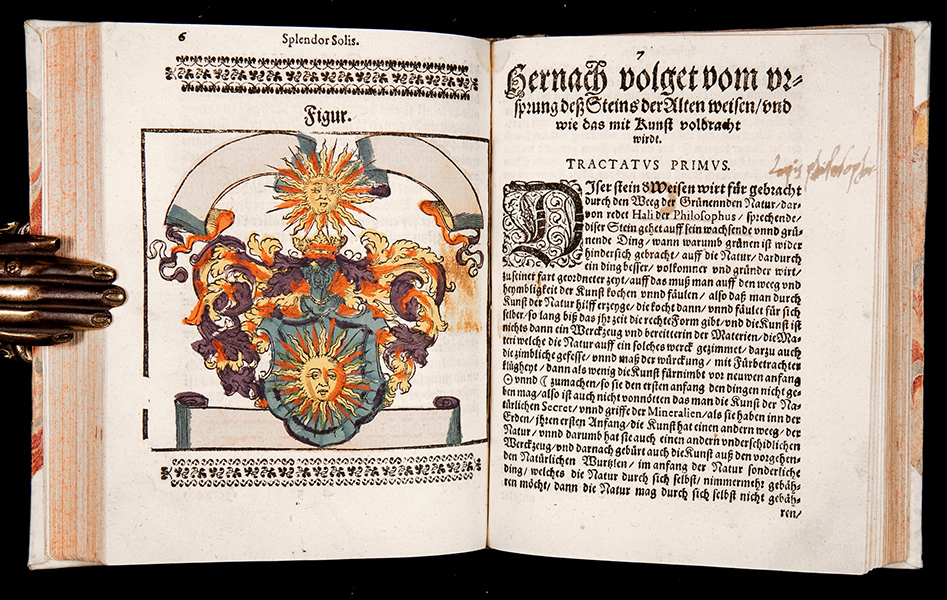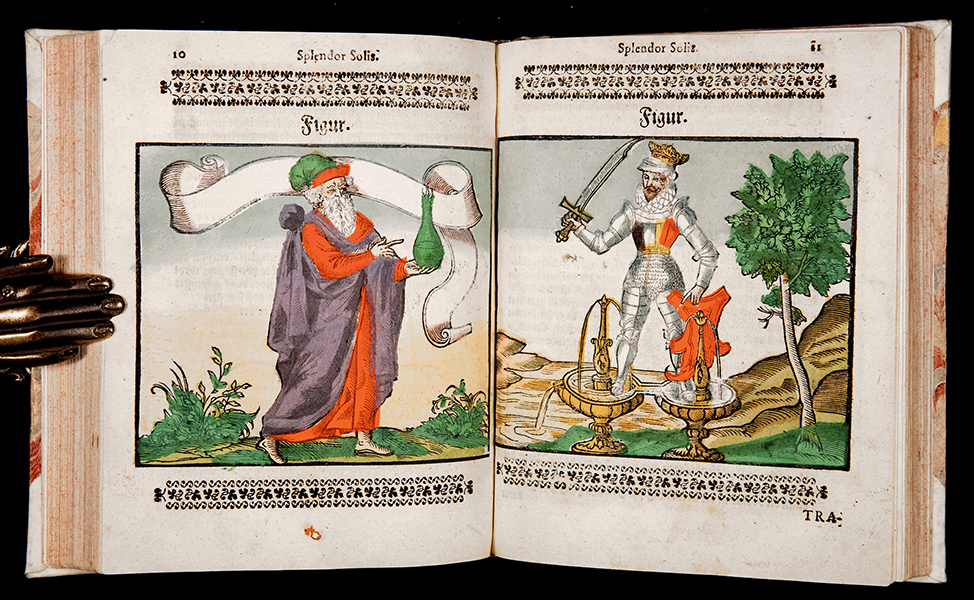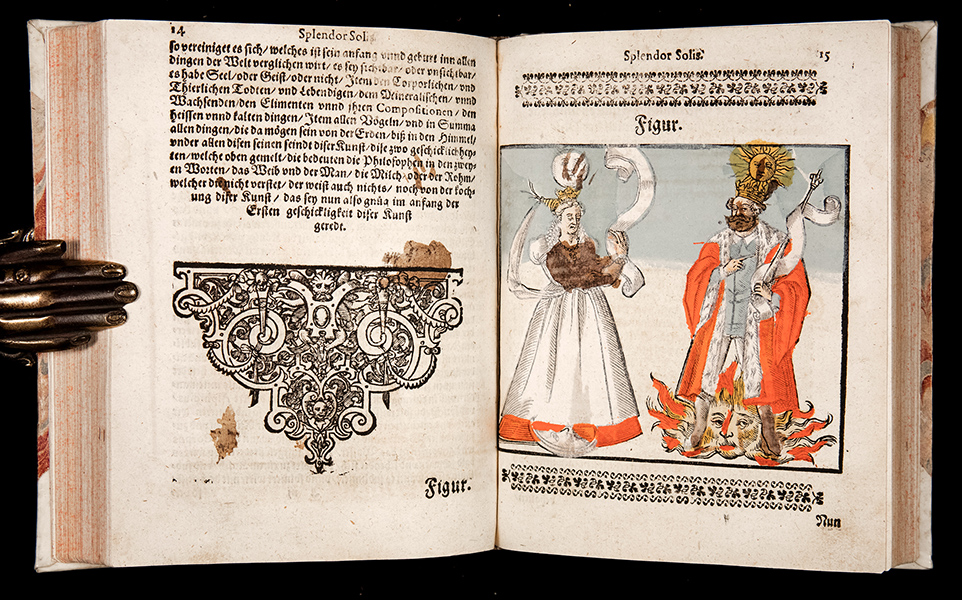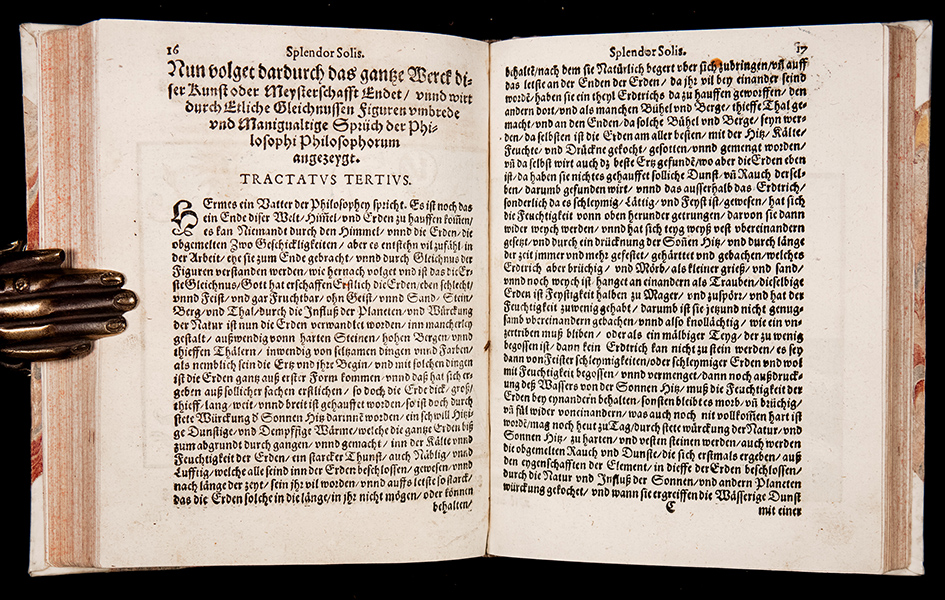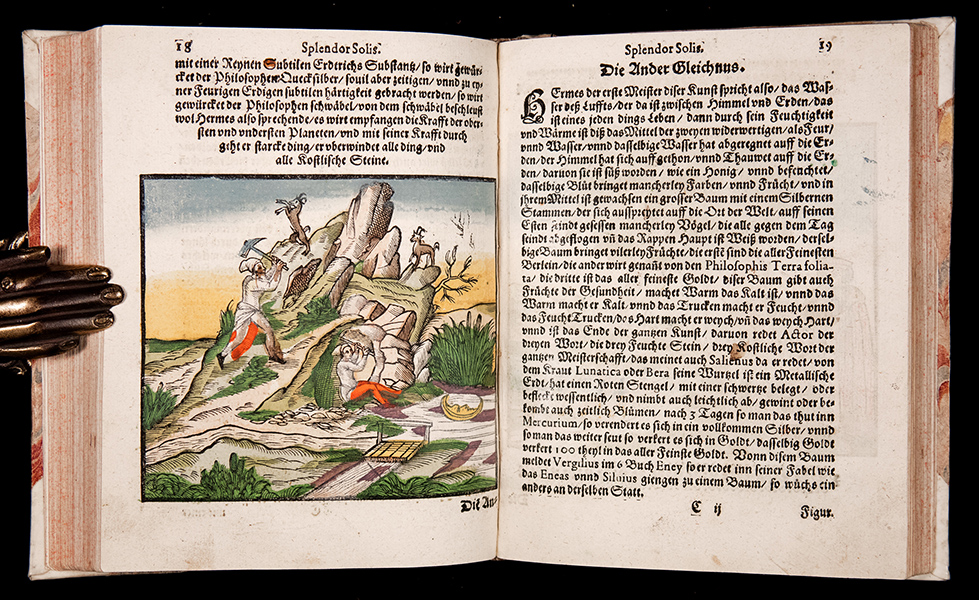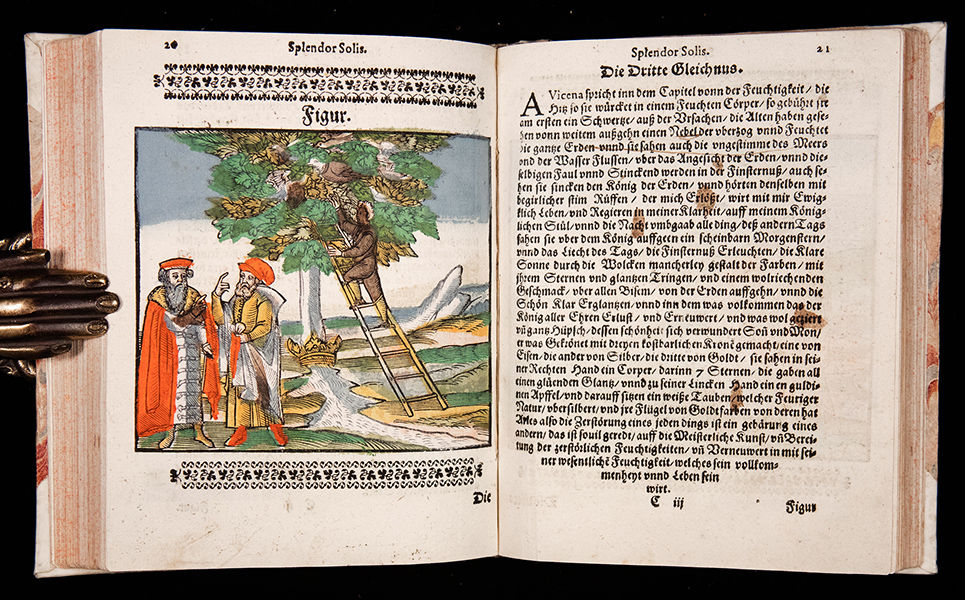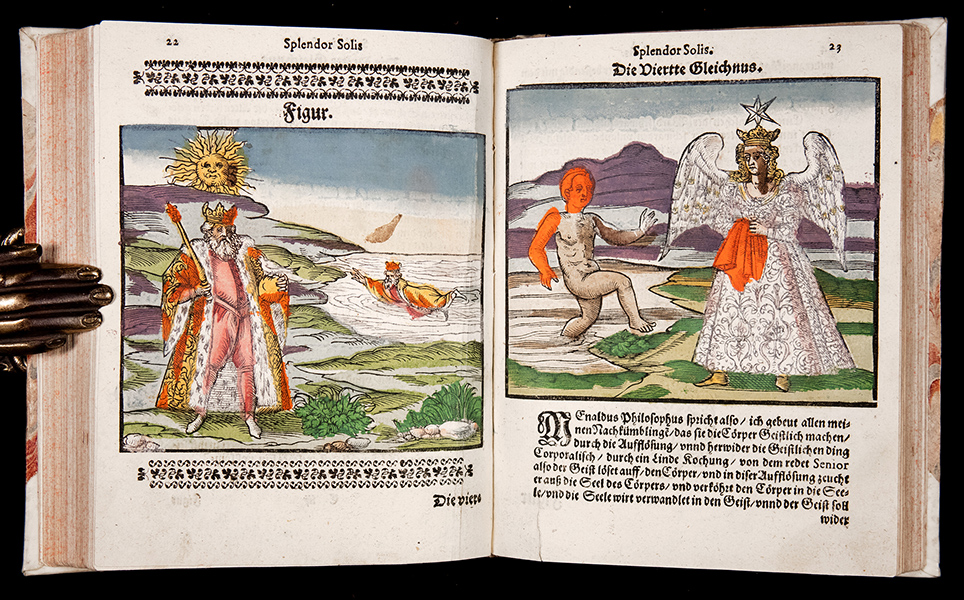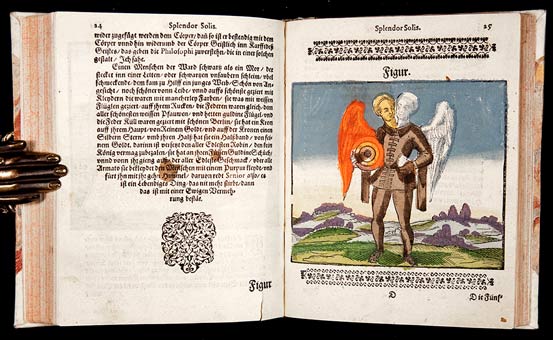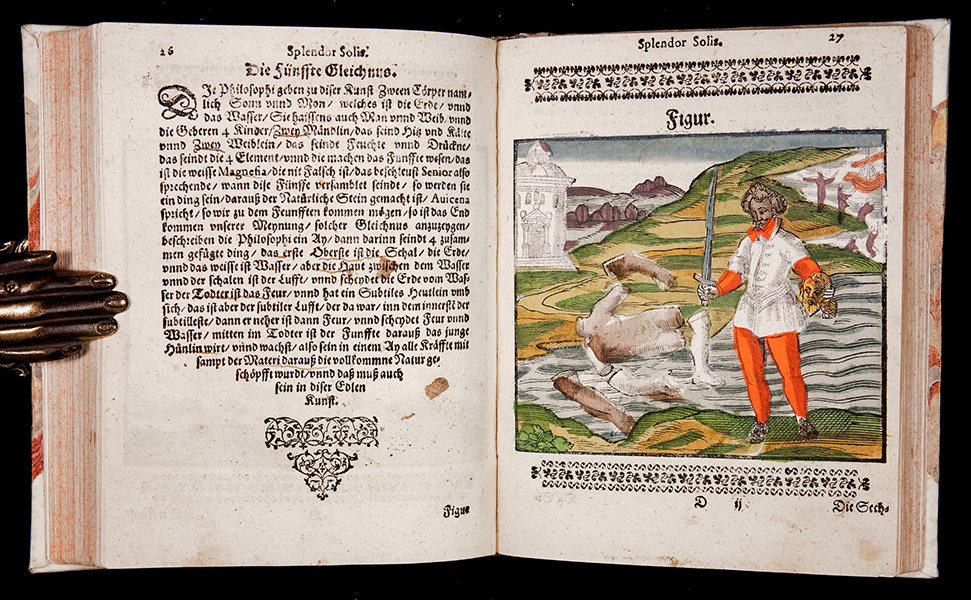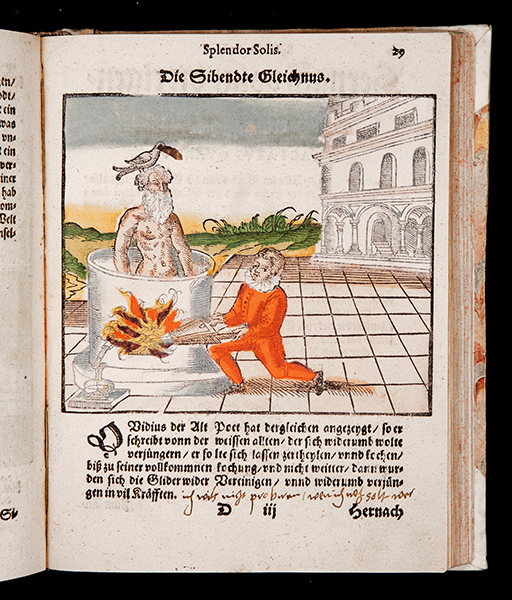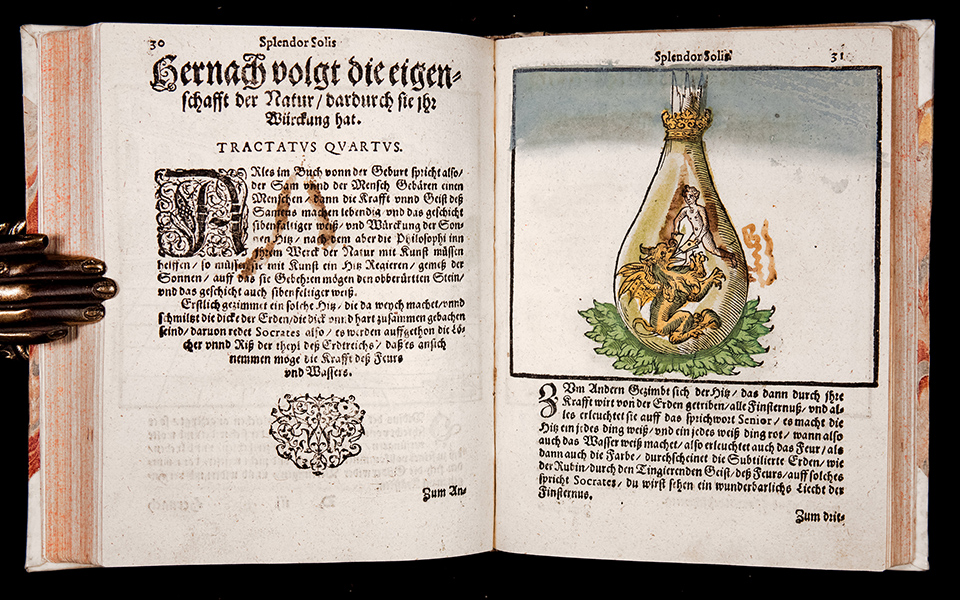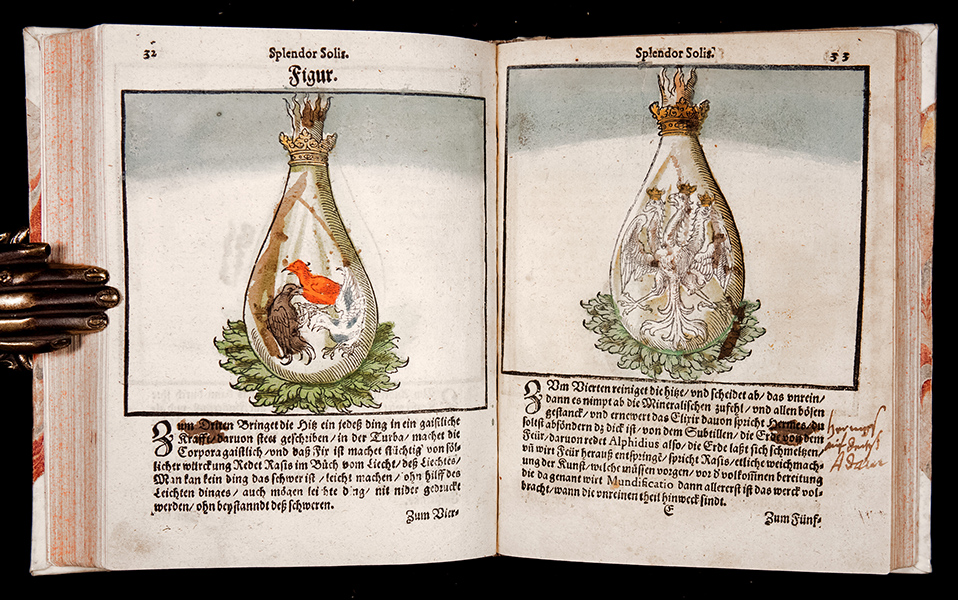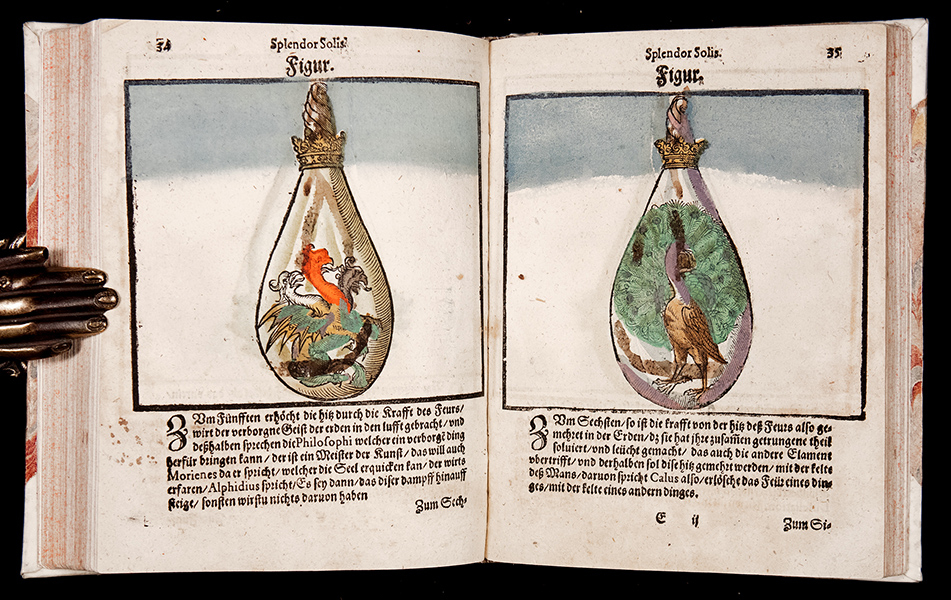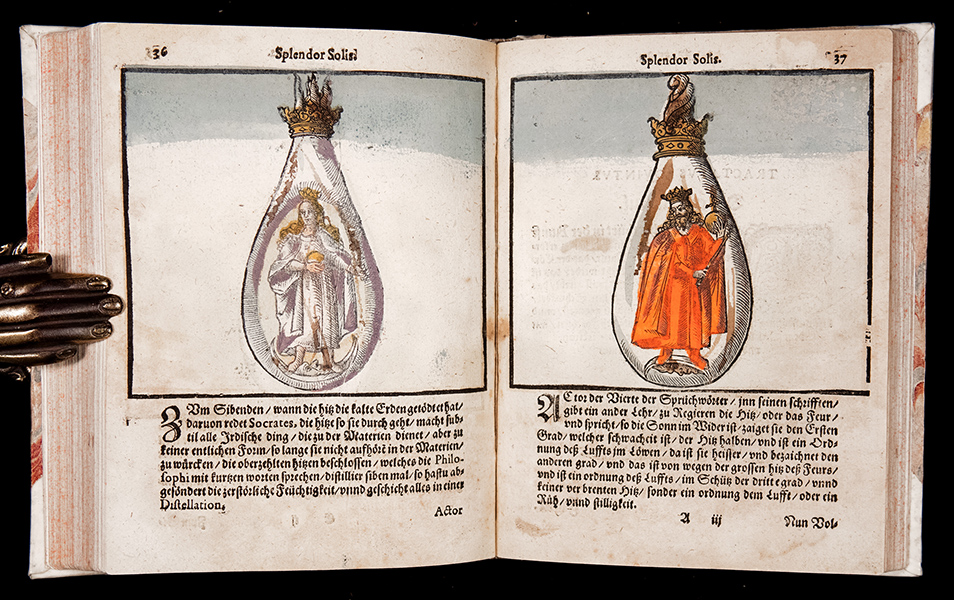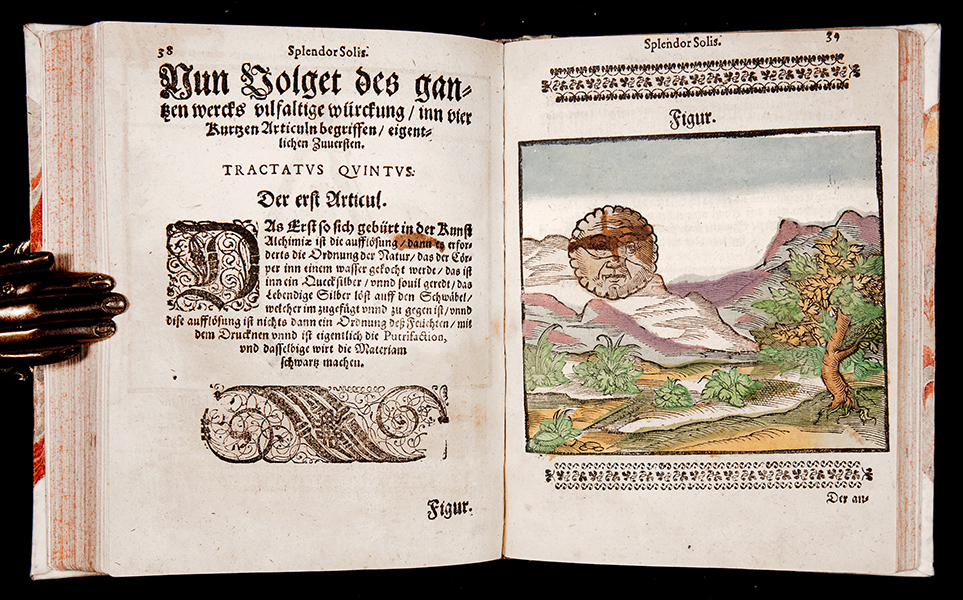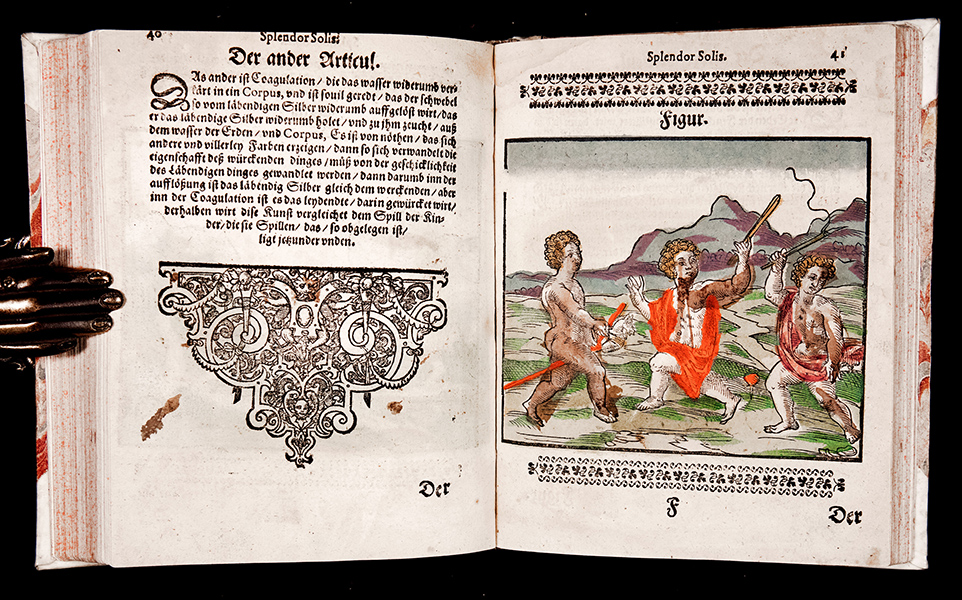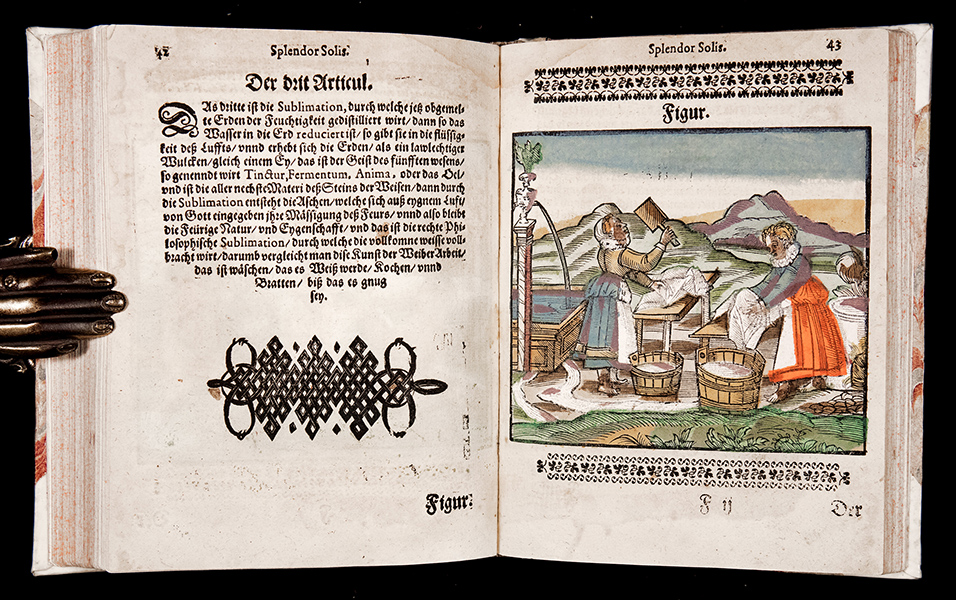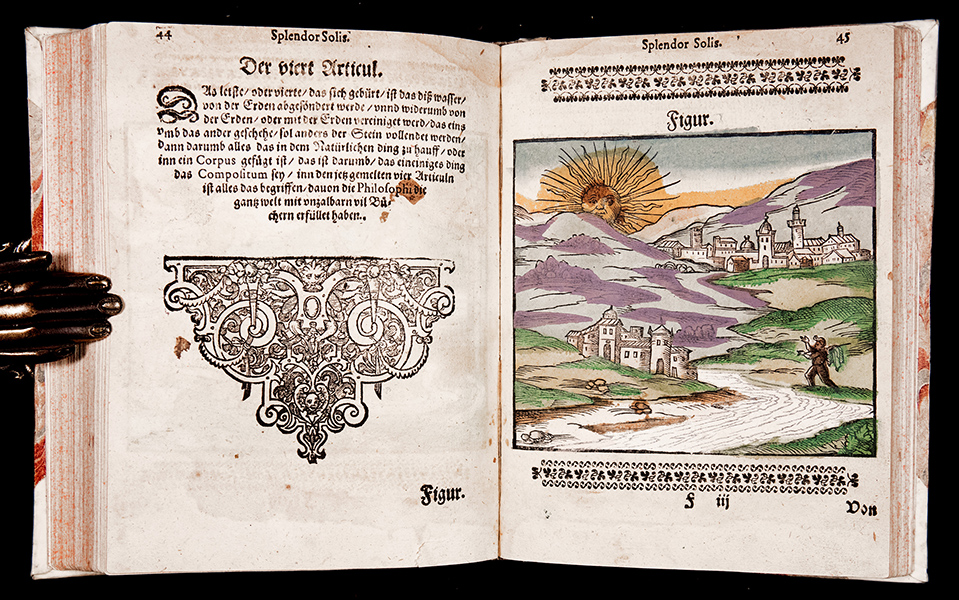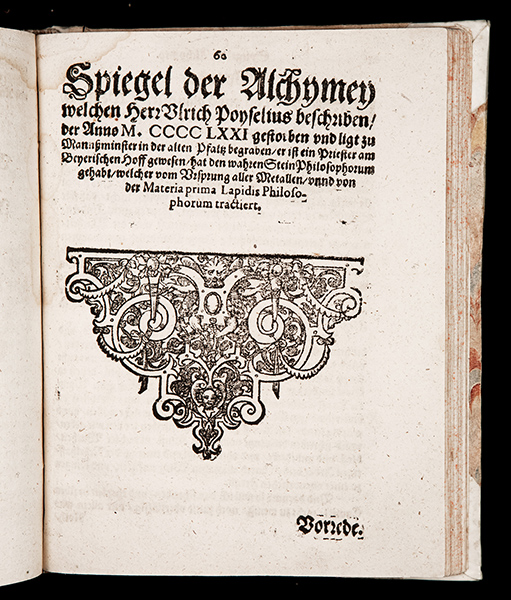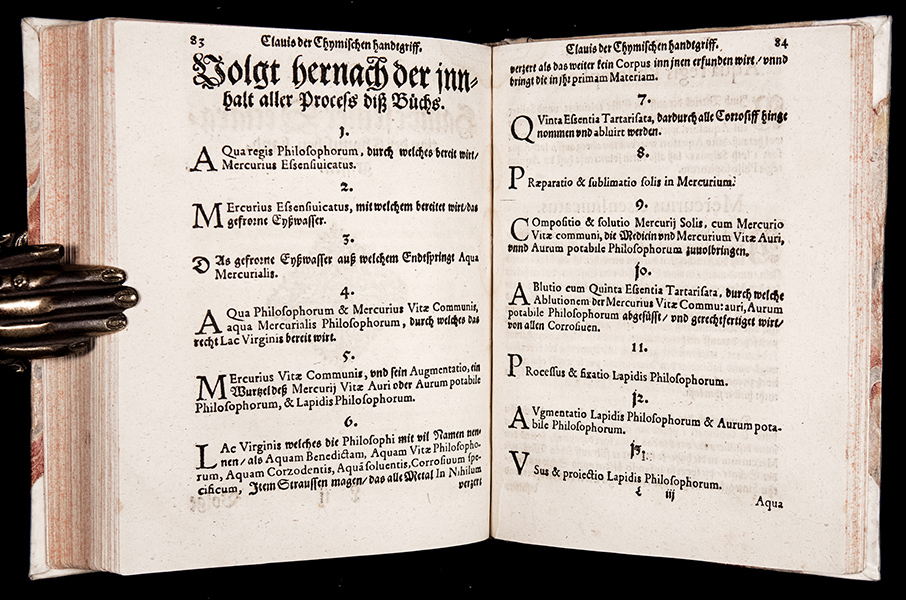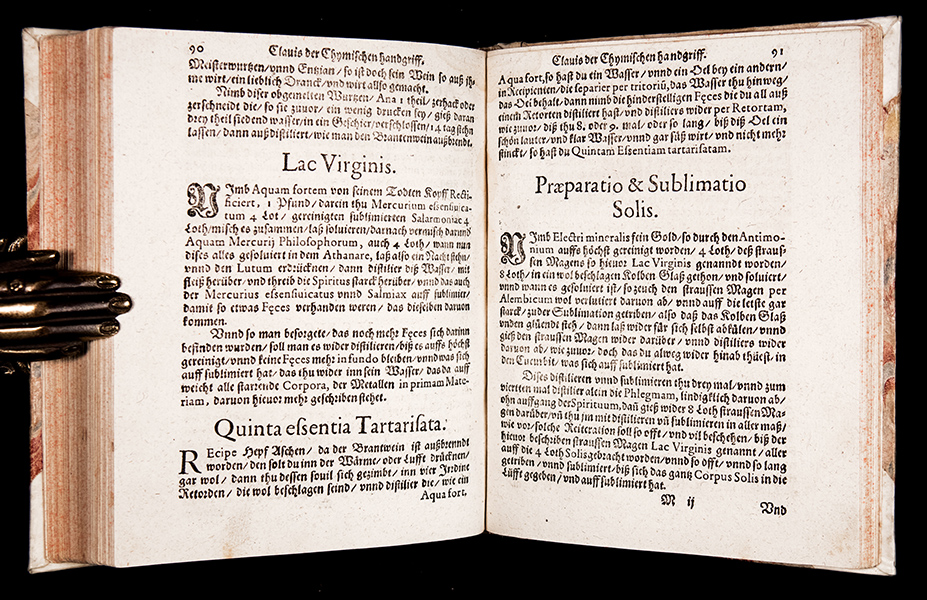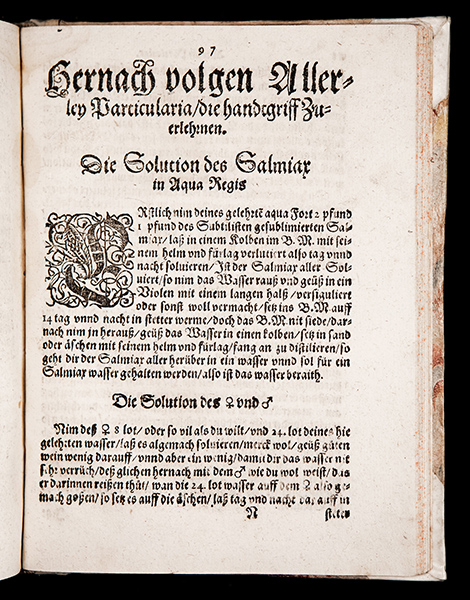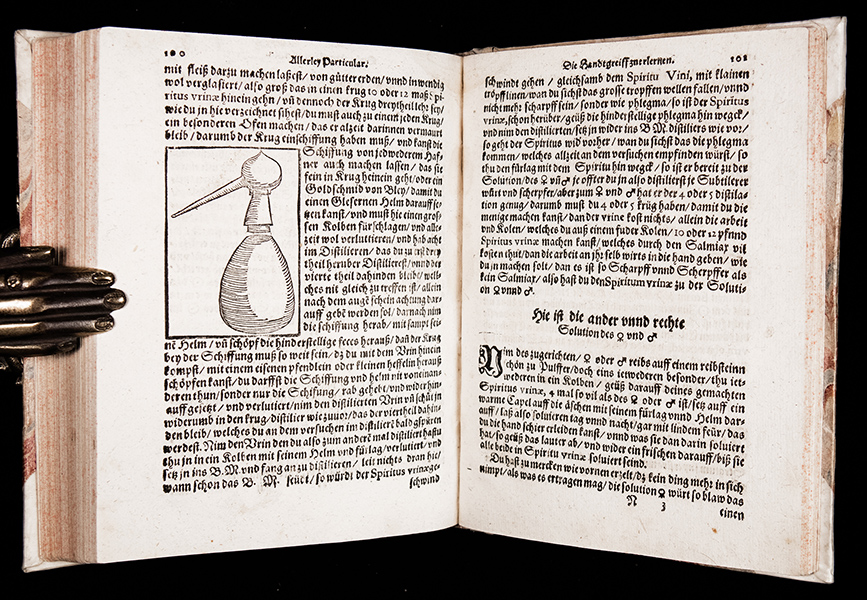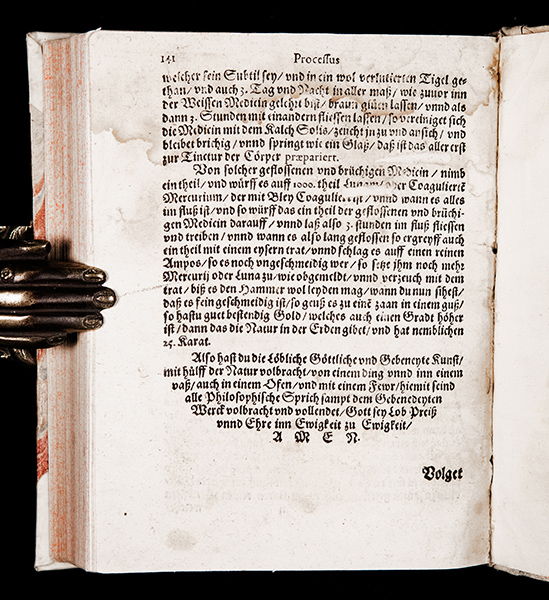

[Alchemy]
Salomon Trismosin [also Paracelsus, Bartholomaus Korndorffer, et al]
Aureum vellus, oder Guldin Schatz und Kunstkammer.
[Splendor Solis]
Rorschach (Switzerland): 'in des F. Gottshausz S. Gallen Reichshoff' [by [Georg Straub]], 1598.
$5,200 INQUIRE ✍
FIRST EDITION. EXTREMELY RARE! Three parts in one volume; Text in German (with some Latin). ILLUSTRATED WITH WOODCUTS COLORED IN CONTEMPORARY HAND.
The general title-page is dated 1598, while the special titles to Parts II and III are undated. A note to the reader at the end of the Table of contents states that publication of parts II and III has been delayed but that they are expected to be finished during the autumn of 1598. According to some catalogues, those parts were printed in 1599.
Rarely found complete, all four copies at the Wellcome Historical Medical Library, the BL copy, the NLM copy, the copy described by Ferguson, are imperfect.
FIRST EDITION of the Aureum vellus (i.e. "The Golden Fleece"), an important alchemical compendium, including the celebrated SPLENDOR SOLIS by an unidentified alchemist calling himself "Salomon Trissmosin," allegedly the teacher of Paracelsus, as well as a number of other alchemical works not only by Trismosin, but by Paracelsus, Bartholomaus Korndorffer, Ulrich Poyselius’ treatise Spiegel der Alchemie, and some anonymous tracts. A curious work at the end of Part II, called ‘Zwei ewige unverlöschliche, brennende, zeitliche Liechter, describing a construction of "everlasting" lamps, burning with "inextinguishable" fire. Although transmitted here by Korndorffer, the work is attributed to Johannes Trithemius (1462 - 1516), a German Benedictine abbot and a polymath Renaissance thinker (active as a cryptographer, occultist, theologian, lexicographer and chronicler), who exerted powerful influence on the development of early modern occultism. As for his ‘everlasting lamps’, "The story went that the abbot of Sponheim had produced these perpetually burning lamps for the Emperor Maximilian I, for which he was paid 6,000 crowns. However that may be, Trithemius was held in high esteem by the emperor and was even appointed court-chaplain." (W. Schrodter, A Rosicrucian Notebook, p.16-17)
The first work of the collection contains a fascinating, ostensibly autobiographical account of Trismosin, in which the author describes how he began his study of alchemy in 1473 after having seen a transmutation by a miner. His study led him to Venice, "where from Egyptian or Arabic books he acquired the whole secret, and made transmutation of all the metals. He met Paracelsus at Constantinople" (Ferguson). Among the tinctures he describes is one which he claims made him suddenly young again, and he claimed being able to prolong his life forever.
The famous illustrated work, Splendor Solis, one of the masterpieces of the Renaissance alchemy, appears here in print for the first time. Prior to the printed edition, it had been circulating in manuscript, considered one of the most beautiful illuminated alchemical manuscripts. Although the style of the Splendor Solis illuminations suggest an earlier date, they are quite clearly of the 16th century. The earliest version is believed to be the manuscript on vellum dated 1532-35, now in the Kupferstichkabinett in the Berlin State Museums, illuminated with decorative borders (beautifully painted and heightened with gold) in the style of a Book of Hours. The later 16th-century copies preserved in London, Kassel, Paris and Nuremberg are equally striking.
The work is structured around a sequence of 22 elaborate images (with text commentary) depicting in a symbolic form the classical alchemical process of death and rebirth of the king, and incorporating a series of seven flasks, each associated with one of the planets. Within the flasks a process is shown involving the transformation of bird and animal symbols into the Queen and King, the white and the red tincture.
The work was frequently cited in works of C. G. Jung dealing with alchemy.
"Written in German, this treatise describes the main steps of the philosophers' stone in a traditional way. It is divided in seven short treatises among which the third and the fourth are themselves separated into seven chapters or paragraphs, the fifth treatise being divided into four articles. The work [in its manuscript form] is illustrated by a series of twenty-two remarkable illuminations which have contributed to its fame. As soon as it appeared, the Splendor Solis had a great reputation. The number of copies, manuscripts as well as printed books, from the middle of the sixteenth century up to the eighteenth century, proves it. [...]
"It should be pointed out that all [the Splendor Solis] manuscripts are anonymous. [...] It is only in the first edition of the treatise, in 1598, at Rorschach on Lake Constance, that the attribution to Trismosin appears in the title. In the printed tradition, the Splendor solis' text is inserted in a score of others describing practical alchemical recipes, and attributed not only to Salomon Trismosin but also to Paracelsus and Korndorffer. The whole is collected under the new title of Aureum vellus. [...] It is well known that for the alchemists of the Renaissance, the Golden Fleece's conquest by Jason was one of the allegories of the philosophers' stone. The Splendor solis constitutes the third book of the Aureum vellus. [...]
"As in the manuscript tradition, the printed books are enriched with a series of twentytwo (sometimes twenty-three) illustrations which here are woodcuts and sometimes touched up with colours. The first text of the Aureum vellus, published at Rorschach in 1598, is actually a kind of autobiography of Salomon Trismosin, or rather an account of his peregrinations. We come to know that Salomon Trismosin's passion for alchemy was born the day he attended a transmutation performed on lead by a miner called Flocker [...] As early as 1473, Trismosin began to travel around looking for an artist who could teach him. [After living in Venice for a while, Salomon] resumed his trip, during which he discovered cabbalistical and magical books written in Egyptian and had them translated into Greek and Latin. These books taught him the tincture methods of the greatest pagan kings [...] which finally revealed to him transmutation’s secrets. Emboldened by this secret, Trismosin asserted that with half a grain of the powder of youth, he had been able to make himself young again and that this "the red lion," could produce the same effect on ninety-year-old women so that they again would be capable of giving birth.
"Salomon Trismosin is undoubtedly a mythical personage. [...] Indeed, the pseudonym of Trismosin has its place next to other pseudonyms from the same period such as Basile Valentin’s. This name also has a symbolic connotation: from antiquity, Salomon was considered to be the great master in magical art; in the same way, Trismosin, which can be read as "three times Moses," constitutes a kind of pair with the Hermes Trismegiste ...
"The sumptuousness of Splendor Solis' illuminations makes it not only one of the most famous works of the hermetico-alchemical tradition, but also one of the monuments of illumination during the Renaissance. [...] A veritable masterpiece of the alchemical iconography of the Renaissance, the Splendor Solis of Salomon Trismosin is, at the same time, both a synthesis and the starting point of several themes of fundamental meaning for the following centuries." (A.-F. Cannella, Alchemical Iconography at the Dawn of the Modern Age. The Splendor solis of Salomon Trismosin in The Power of Images in Early Modern Science, ed. by W. Lefèvre, pp. 107-114)
Physical description:
3 parts in one volume (with separate pagination and title-pages).
Quarto; textblock measures 19 cm x 14.5 cm. Bound in 18th-century quarter-vellum over marbled paper-covered boards with vellum corners, flat spine titled in manuscript; edges speckled red (endpapers replaced at a later date).
Pagination and collation:
Part I: [8], 115 (i.e. 117), [1, Lectori], [2 blank]; signatures (:)4 A-P4 (eight final leaves, i.e. quires O-P4 misbound after Part II).
Part II: [2], 102; signatures A-N4;
Part III: 141 (i.e. 140); signatures A-R4 S2
Parts I and II COMPLETE; Part III incomplete at the end, lacking pp.141-240 (containing a few miscellaneous treatises, mostly anonymous and unillustrated), the SPLENDOR SOLIS is COMPLETE with all its fine illustrations.
Please NOTE that this first edition is VERY RARELY FOUND COMPLETE: all four copies at the Wellcome Historical Medical Library (London), the British Library copy, the the National Library of Medicine (NLM) copy, the copy described in Ferguson's Bibliotheca chemica, are all incomplete.
Title-pages printed in red and black (parts II and II have special title-pages). FULL PAGE PORTRAIT OF PARACELSUS (on A2v) in Part II with partial contemporary handcoloring, 22 LARGE ALCHEMICAL WOODCUTS OF ALCHEMICAL ALLEGORIES to the Splendor Solis in Part III WITH FINE CONTEMPORARY HANDCOLORING, and several further in-text illustrations of alchemical vessels and apparatuses, some handcolored in wash. Woodcut decorative initials and head- and tail-pieces.
Provenance:
Bookplate of the Säfstaholms Bibliothek, incorporating the owner's initials 'GTB', i.e. Gustaf Trolle-Bonde (1773 - 1855), a Swedish count, a patron of the arts and collector of books and paintings, known as "the Blind Excellency". He inherited Sävstaholm Castle (in Södermanland County, Sweden) in 1797 and rebuilt and redesigned large parts of the estate to house his growing art collection and library. His massive library was sold in 1920. The estate is now an art museum showcasing Swedish artists from the early 20th century.
In early 21st century the book was a part of the inventory of Adrian Harrington, a prominent London antiquarian book dealer (his catalogue description and a £6,750 price-tag are loosely laid in).Condition:
Very Good antiquarian condition. Binding rubbed and lightly soiled; spine slightly bowed. Interior with occasional light soiling and minor spotting, including a few ink-blots, some offsetting and bleed-through from hand coloring resulting a few blotches or smudges; Some infrequent, light marginal water-staining; last 6 leaves with heavier dampstaining and some fraying, repair to the fore-margin of leaf S1 (not affecting any text). In Part III leaf C3 slightly creased and C4 with a short closed tear to bottom margin (no loss). A few leaves with minor contemporary marginalia in German. Top margin cropped somewhat close, on a few leaves touching the running heads. Rear free endpaper slightly torn. In all, a clean, well-margined copy with appealing contemporary handcoloring.
Bibliographic references:
Caillet 10840; Ferguson II, 469; Durling, NLM 3519; Wellcome 6357.
